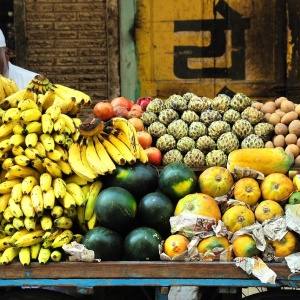
This modelling paper finds that strategies to mitigate climate change could put an additional 160 million people at risk of hunger by 2050, if they are not designed carefully. However, these trade-offs could be avoided at a cost of around 0.2% of GDP in 2050.
In the models, risk of hunger is affected by climate mitigation policy through three factors: increased land rents due to competition between food and bioenergy crops; the cost of mitigating non-CO2 emissions; and a carbon price imposed on ongoing non-CO2 emissions that are not prevented by the aforementioned reduction measures.
The risk of hunger spikes between 2030 and 2040, as carbon prices increase. The response of risk of hunger to food prices depends on the price elasticity of food demand, i.e. how much demand changes as prices change. Food demand in higher income countries is predicted to change relatively little in response to increased food prices, compared to lower income countries, since wealthier people can afford to spend more on food.
The paper gives a rough estimate of the costs of avoiding the additional risk of hunger associated with climate mitigation, either through agricultural subsidies or through food aid either for everyone or only for those at risk of hunger. Agricultural subsidies would cost around 0.6% of GDP for the most stringent mitigation scenario (limiting climate change to 1.5 °C), while direct food aid would cost 0.2% of GDP in the same scenario. The costs of food aid could be further reduced (to 0.01% of GDP) if only those at risk of hunger are given food aid, but this is a lower bound on the cost estimate since it does not account for the cost of implementing a system to determine who is at risk of hunger.
Abstract
Holding the global increase in temperature caused by climate change well below 2 °C above pre-industrial levels, the goal affirmed by the Paris Agreement, is a major societal challenge. Meanwhile, food security is a high-priority area in the UN Sustainable Development Goals, which could potentially be adversely affected by stringent climate mitigation. Here we show the potential negative trade-offs between food security and climate mitigation using a multi-model comparison exercise. We find that carelessly designed climate mitigation policies could increase the number of people at risk of hunger by 160 million in 2050. Avoiding these adverse side effects would entail a cost of about 0.18% of global gross domestic product in 2050. It should be noted that direct impacts of climate change on yields were not assessed and that the direct benefits from mitigation in terms of avoided yield losses could be substantial, further reducing the above cost. Although results vary across models and model implementations, the qualitative implications are robust and call for careful design of climate mitigation policies taking into account agriculture and land prices.
Reference
Fujimori, S., Hasegawa, T., Krey, V., Riahi, K., Bertram, C., Bodirsky, B. L., Bosetti, V., Callen, J., Després, J., Doelman, J., Drouet, L., Emmerling, J., Frank, S., Fricko, O., Havlik, P., Humpenöder, F., Koopman, J. F. L., van Meijl, H., Ochi, Y., Popp, A., Schmitz, A., Takahashi, K. and van Vuuren, D. (2019). A multi-model assessment of food security implications of climate change mitigation. Nature Sustainability, 2, pp.386–396.
Read the full paper here (PDF link). See also the Foodsource building block What is food security?







Post a new comment »